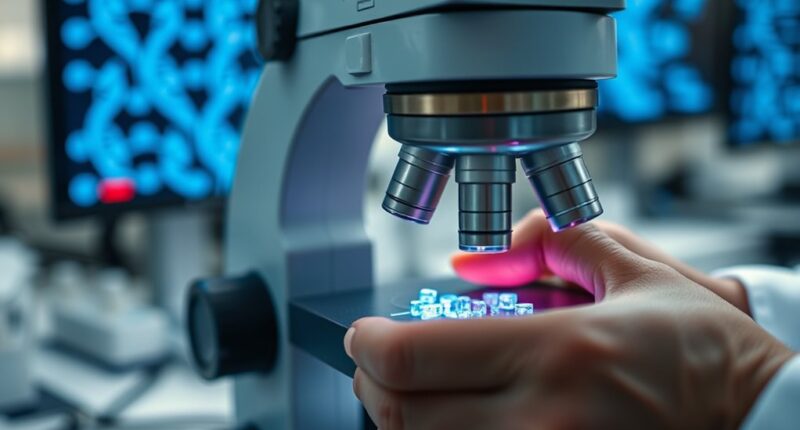The latest ethical guidelines stress that gene editing of babies with CRISPR should be done with extreme caution, emphasizing strict oversight and moral responsibility. They warn against premature applications, highlighting risks like unforeseen health issues, societal inequalities, and safety concerns. Focus is on transparency, thorough research, and international cooperation to guarantee responsible use. If you want to discover how experts are guiding this delicate balance, there’s more to explore below.
Key Takeaways
- The latest guidelines emphasize restricting heritable gene editing to strict research contexts to prevent premature clinical use.
- They highlight the importance of transparency, informed consent, and international cooperation in responsible gene editing.
- Safety, long-term risks, and societal impacts are central considerations guiding cautious, ethical advancement.
- Robust oversight, peer review, and public engagement are essential safeguards before any clinical application.
- Ethical principles prioritize minimizing harm, ensuring societal values align, and recognizing the moral responsibilities of scientists.

Have you ever wondered what happened after the world first learned about the gene-edited babies? The announcement by scientist He Jiankui in 2018 shocked everyone, raising immediate questions about the consequences and responsibilities tied to gene editing. Since then, the conversation has shifted from excitement to caution, especially regarding heritable modifications—changes made to an embryo’s DNA that can be passed down through generations. This development sparked a global debate on gene editing ethics, emphasizing that altering human DNA isn’t just a scientific milestone but a moral one as well.
The latest ethical guidelines aim to establish boundaries and guarantee responsible use of CRISPR technology. They stress that heritable modifications should only be pursued within strict research contexts, avoiding premature clinical applications. These guidelines recognize that editing genes in a way that could be inherited raises profound concerns about unforeseen consequences, long-term safety, and societal impacts. You’re encouraged to see these restrictions not as obstacles but as safeguards, protecting future generations from potential harm caused by unproven or reckless interventions.
The ethical landscape emphasizes transparency, informed consent, and international cooperation. It’s vital that scientists and policymakers openly discuss the implications of heritable modifications, acknowledging that once DNA is edited, it’s nearly impossible to fully predict all outcomes. The guidelines make it clear that gene editing should be confined to research environments until it’s proven safe and ethically justified. They also underline that the potential benefits—like eradicating genetic diseases—must be weighed carefully against risks, including unintended health issues or social inequalities that might arise from unequal access or misuse.
You should understand that these guidelines reinforce a cautious approach, emphasizing that gene editing ethics isn’t just about legality but about moral responsibility. It’s about considering the welfare of future children and society at large, not just scientific advancement. They call for international consensus to prevent a patchwork of regulations that could lead to risky or unethical practices. The guidelines advocate for robust oversight, peer review, and public engagement, ensuring that the conversation around heritable modifications remains transparent and inclusive.
In essence, the latest guidelines serve as a reminder that while CRISPR has incredible potential, it demands careful stewardship. You’re part of a global community that must navigate these ethical waters with humility and responsibility. As the science advances, so must your awareness of the moral implications, guaranteeing that humanity’s pursuit of genetic mastery doesn’t override our commitment to ethics and safety. Recognizing that privacy and cookie usage can be relevant even in discussions about sensitive genetic information highlights the importance of responsible data handling and international standards.
Frequently Asked Questions
What Are the Long-Term Health Risks of Gene Editing?
You might wonder about the long-term health risks of gene editing, such as genetic stability concerns and unforeseen mutations. These changes could cause unintended effects that might not surface until years later, potentially leading to health issues or genetic disorders. While gene editing offers promising benefits, you should be cautious, as the technology still carries risks of unpredictable mutations that could impact your health or future generations.
How Do Ethical Guidelines Vary Globally?
Imagine each country as a different chef with unique recipes—ethical guidelines vary globally, influenced by cultural perspectives and religious considerations. For example, some nations prioritize individual choice, while others emphasize social harmony. These differences shape laws on gene editing, making international consensus challenging. You must navigate these diverse views, understanding that what’s acceptable in one country may be taboo in another, much like how recipes reflect cultural identity.
Who Should Oversee CRISPR Research Ethically?
You should recognize that overseeing CRISPR research ethically requires a balance of bioethical oversight and respect for genetic sovereignty. A dedicated international body, comprising scientists, ethicists, and policymakers, must set standards to prevent misuse and protect individual rights. This guarantees responsible innovation, aligns global efforts, and upholds ethical principles, so you can trust that CRISPR advancements serve humanity without infringing on personal or cultural genetic sovereignty.
Can CRISPR Be Used for Non-Therapeutic Enhancements?
This question about using CRISPR for non-therapeutic enhancements is a Pandora’s box you shouldn’t open lightly. You could create designer babies with cosmetic enhancements that go beyond medical needs, raising profound ethical concerns. While it’s technically possible, many experts argue it crosses moral boundaries and could lead to a society obsessed with perfection. You must consider the long-term implications before endorsing such controversial genetic modifications.
What Are the Legal Implications of Creating CRISPR Babies?
When you consider creating CRISPR babies, you face complex legal implications surrounding germline modification, which can be passed to future generations. Laws vary by country, and many require strict regulations or ban such practices. Informed consent is essential, but it’s challenging since the future child’s rights can’t be fully known. You must navigate these legal and ethical boundaries carefully to avoid violations or unintended consequences.
Conclusion
As you stand at the crossroads of science and morality, imagine a future where gene editing shapes lives like delicate threads in a vast tapestry. The latest ethical guidelines act as your guiding compass, steering you away from shadows of controversy and toward a horizon of responsible innovation. Remember, with each decision, you’re weaving a story—one that could define generations. Embrace this moment with awareness, knowing your choices hold the power to illuminate or darken the path ahead.










